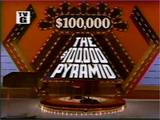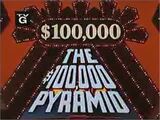| Hosts | |
| Dick Clark (1985-1988) John Davidson (1991) | |
| Announcers | |
| Johnny Gilbert Bob Hilton Charlie O'Donnell Charlie Tuna Henry Polic II Dean Goss | |
| Broadcast | |
| Syndication: 9/9/85 - 9/2/88 Syndication: 01/07/91 - 12/06/91 | |
| Origination | |
| CBS Television City, Hollywood, California | |
| Packager | |
| Bob Stewart Productions/Stewart Tele-Enterprises Carolco Pictures Television (1/6/91-5/3/91) | |
| Distributors | |
| 20th Century Fox Television (1985-1988) Orbis Communications (1/6/1991-5/3/1991) Multimedia Entertainment (5/6/1991-12/6/1991) | |
This is chronicling The $100,000 Pyramid.
Game Format[]
Main Game[]
The game is played with two teams of two players (consisting of one celebrity & one contestant) in a game of word communication. Each game starts with the introduction of six categories arranged in a pyramid. In the main game, a category's position on the pyramid was not an indicator of its difficulty. The categories were usually puns hinting to the content within that subject.
Each team in turn chose a category, and then a subject under that category was given. Each subject has seven words/phrases/names. The team had 30 seconds to guess the seven answers that fit into the category. One player described each item while the other player tried to guess what the words are. Each correct word was worth one point. When a word was passed, it cannot be returned to, but if the guesser can guess the word already passed, the team still scored. If at any time the clue giver gave away any part of the answer or conveyed the essence of the answer, a cuckoo sounded and the word was thrown out.
Each team had three turns with the celebrities giving first in round one, the contestants giving in round two, and in round three they decided amongst themselves on who's giving and who's receiving.
Special Bonuses[]
At some point in the game, a team would uncover a special card behind one category prompting a bonus situation. To win the bonus, the team had to get all the answers right. In situations where a team can win the game without needing all the answers or has won the game automatically, if the last category concealed a bonus, the team was allowed to play all the way out in order to win the bonus.
- 7-11 - The team that exposed the 7-11 had 30 seconds to get all seven and win $1,100. On April 12, 1991, it was scrapped in favor of Gamble for a Grand.
- Mystery 7 - It was always played in the second game. The team that found the Mystery 7 had a chance to win a special prize. It's called the Mystery 7 because the category was not told until after it was done. The team had the usual 30 seconds to get all seven words. The Gamble for a Trip replaced the Mystery 7 on the Tuesday and Thursday shows. The Mystery 7 continued to be used on the Monday, Wednesday, and Friday shows in the meantime.
- Double Trouble - This was played in either game. It premiered on January 8, 1991. This category had its seven answers be two words long. The team had 45 seconds instead of 30 to get all seven two word answers. Getting all seven answers won $500. There were two Double Trouble categories in the game whenever it appeared; each team only gets one giving both teams a chance at $500.
- Gamble for a Grand/Trip - This was the replacement for the 7-11 and the Mystery 7 (on the Tuesday & Thursday shows only). This was where the team that found it can decide to give up five seconds of time (making the time 25 seconds) for a chance to win $1,000 or a trip.
Tie-Breaker[]
If the game ended in a tie, both scores were deleted and the game shifted into a tie-breaker situation. The team that caused the tie had a choice between two letters leaving the other for the other team. Both teams had 30 seconds to get as many of the seven items beginning with their letter(s) as they can. The team that got the most out of seven won the game. If the first team got seven, the time remaining on the clock was subtracted from 30 to give the time that the other team needed to get seven. During the 80s version, if the game ended in a 21-21 tie, the team that broke the tie won $5,000 to the contestant.
The team with the most points won the game.
Winner's Circle[]
The giver of the winning team faced a larger pyramid board of six subjects with the guesser having his/her back to the board. The winning team had 60 seconds to climb up to the top of the pyramid by getting all six. On each subject, the giver gave a list of items that fit the subject while the guesser tried to guess what they all have in common. As soon as the guesser gets the right subject or passed, they moved on to the next subject to the right. Upon a pass, the team can come back to it if there's time leftover though the guesser can still get the subject without going back to it. If at any time the giver gave an illegal clue (giving away part of the answer, conveying the essence of the answer, descriptions of the category, prepositional phrases or a synonym) a buzzer would sound, the subject was re-concealed and the team forfeited the chance at the big money. The giver was discouraged from using his/her hands which is why they were strapped into the chair. Even though the big money was forfeited, the team can still go for the other subjects, because when time ran out, the contestant still won money attached to the subjects guessed; of course, getting all six in 60 seconds without illegal clues won the grand cash prize.
Payoffs[]
Here are the amounts for each subject:
| 1st | 2nd | 3rd | 4th | 5th | 6th | HPT | TOTAL |
| $50 | $100 | $150 | $200 | $250 | $300 | $1,000 | $1,050 |
The first trip was worth $10,000, and the second trip was worth a total of $25,000 ($10,000 win in the first WC means the second is worth $15,000; otherwise, a win in the second WC augmented the first WC earnings to $25,000).
Game/Championship Formats[]
Each episode was made self-contained for it had the contestants play two games every show. Any money won from the Winner's Circle was used as score money not counting bonuses. The player with the most money or won both games returned to play the next show. If the show ended in a tie both contestants returned to play the next show. Contestants retired after five wins.
Tournaments[]
The three players who won the Winner's Circle in the shortest time during a given period of shows (usually 13 weeks) returned on later episodes to compete in a tournament. The players alternated in a round-robin, with two players competing each day and the third player replacing the loser of that episode in the next one, if neither player won the Winner's Circle that day (in the event of a tie, a coin toss was used to determine who returned on the next show). The first player to win the Winner's Circle won $100,000 and ended the tournament. If a $100,000 win happened in the first game of the show, the two remaining players played the second game for a possible $10,000. No bonus cards were in play during a tournament, although during the 80's run the $5,000 bonus for a 21-21 tie remained intact.
Trivia[]
John Davidson hosted the 1991 version while Dick Clark hosted & produced The Challengers.
In the 1991 version, the last word of each category was signified by a little triangle.
Also in the 1991 version, save for one episode, the $100,000 sign did not flash while the lights of the set chased. It only flashes when the $100,000 was won.
The biggest total awarded was $150,800, also the highest total in franchise history. Second highest was $147,750.
When a contestant won $100,000, the trilons would wiggle back and forth and more often than not, the other tournament contestants and the audience would barrage to the stage.
Music[]
Bob Cobert


